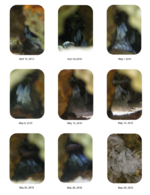Photobucket says you have moved or deleted the photo using the link so I did not get to view it.
If you can find a source for crab hatchlings via mail order, PLEASE post. I have never found one. Thales is trying some that are local (they come from the SF bay area) and spawning in the aquarium but most of us don't have this opportunity. It is the most likely food that will get us somewhere as we have seen a few minor successes in public aquariums where this was the food.
Baby (new hatch) brine is both a warning and a note of interest. Brine have NO food value but new hatch (12 or fewer hours after hatching) still have a yolk sack that provides some nutrition, but not enough for a growing ceph. The size and movement (because the octos appear to eat them) is more the reason for the reference. You can't gut load the brine because they don't eat at this stage (hence the yolk sack) and we are not at all sure what is missing from their diet to to try to coat brine with anything that might work. Feel free to try (Selcon has not been successful) anything that comes to mind though because there are no successes.
Here is a link to Kooah's hatchlings:
http://www.tonmo.com/forums/forum/c...from-eggs/14595-kooah-s-hatchlings-o-briareus
You will have to read through the text to try to understand some of the things I tried (these were briareus and only two survived through adulthood but that is two more of this species than anyone I know so I count myself very lucky) One of the attempts was to add egg white as a member studying another species had a hunch about albumin (available in pure forms but egg white is something we all can get). Adding it to the tank water was unsuccessful but if you want to mess with new hatch brine and trying to "coat" them, this might be a substance to try.
I also tried using a foot bath to experiment with current. I tried constant current and a make shift on/off timer for intermittent. This is still a thought but the food bath did not produce a directional flow and I could not turn it down very far. I think the force of the bubbles was far to great. This was probably the shortest lived tank.
My filter sock suggestion will only be viable if you use one in your current set-up. My tanks are set up to gravity drain to a sump below. The water that leaves goes to the sump is first filtered through a polyester sock containing a bag of charcoal. If you use a canister, this won't be an option you can easily experiment with unless you can feed a filter sock after the canister. This is what the sock look like:
Search results for: '' - Bulk Reef Supply (7", 4" overflow in a day) and I make PVC hangers from pipe and elbows to suspend them.
Unfortunately, hatching time is a guessing game. Often the eggs will hatch over a period of days and you will see a few the first day and the majority on the second followed by a few more over anywhere from 2 to 7 days (10 days has been the longest I remember). You will notice tiny white "ticks" either swimming or on the glass as they start hatching. The WILL go out the overflow and preventing all of them from taking this route requires creativity. If you can screen off you overflow, this will help. If you are using a canister, they will not survive the trip. If you use gravity to a sump and pump up, the return trip will be fatal but you may be able to cordon off the pump. I have used large breeder nets with success for O. mercatoris but O. briareus would not stay in the net. If you are using an skimmer in the display tank, I would shut it down when you see hatchlings as they will find their way into the pump. Tony made some size adjustments for the photos so I will try again to post the not so clear picture of the stages

